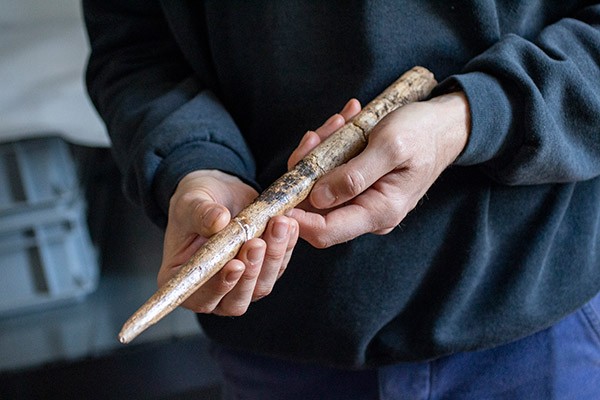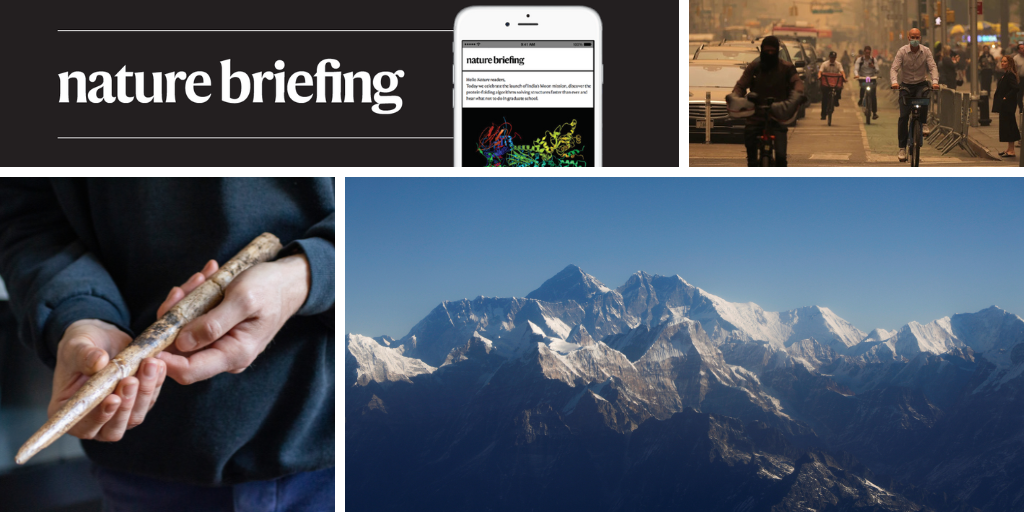You have full access to this article via your institution.
Hello Nature readers, would you like to get this Briefing in your inbox free every day? Sign up here.

Climbers can spend weeks or even months on Mount Everest to adjust to the altitude before they attempt to reach the summit. (Monika Deupala/Reuters)
Four climbers have become the first to reach the summit of Mount Everest using xenon gas to adapt to the low-oxygen environment. The group slept in tents that simulated the high-altitude conditions before heading to the mountain, and reached the peak just five days after leaving London. “Xenon improves the acclimatisation and protects the body from altitude sickness”, which makes the climb safer and shorter, says mountaineer and expedition organizer Lukas Furtenbach. Shorter expeditions could lower the environmental impact of such trips, he says.
US scientists are rallying to save the Human Studies Facility — a lab that’s been instrumental in documenting the impact of air pollution on human health. The US government cancelled its long-standing lease with the facility’s host university, and the Environmental Protection Agency (EPA), which runs the lab, is now moving out of the state-of-the-art facility. “We need this capability,” says Dan Costa, a former EPA toxicologist. “Virtually all of the air-quality standards that we have today are built around evidence from this exposure facility.”
Populations of bed bugs (Cimex lectularius) that feed on humans boomed approximately 8,000 years ago — around the same time as the first cities started to form. The findings hint that these insects were the first urban pests. “When we started to live in cities, we brought all these people together, and they all had their own bedbugs with them,” says entomologist Warren Booth.
Reference: Biology Letters paper
Features & opinion
To reach the brain, drugs must pass through the highly-selective blood-brain barrier. Large molecules, such as antibodies, don’t cross easily, if at all. Now, small chemical tags that can ‘shuttle’ drugs across the barrier are offering a way forward. Several such shuttles, which take advantage of natural transport systems, are in the works. Some have already been trialled in rare diseases, with signs of success. The field is in its infancy, but these shuttles promise to revolutionize treatments for diseases from Alzheimer’s to cancer.
In her book Anatomy of a Train Wreck, science historian Ruth Leys examines the controversial psychological field of ‘social priming’. Leys explores how what was once hailed as a breakthrough ultimately became a cautionary tale after a reproducibility crisis. But “Leys’s critique is just one side of an active debate in the field”, say philosophers Eduoard Machery and John Doris in their review. “We think, like Leys, that studying scientific failures is important for developing a historically and philosophically accurate grasp of science,” they say. However, they add that “readers ought to proceed with caution” when considering Leys’s philosophy.
To cope with the increasing demands of their jobs, some pathologists — specialists who study diseases by examining samples of bodily fluids and tissues — are turning to artificial intelligence (AI). Scientists have designed AI models to perform tasks such as classifying illnesses, predicting treatment outcomes and identifying biological markers of disease using digitized images of microscope slides. But not all pathologists are in agreement that AI is the way forward — at least not in the short term. The tools haven’t been validated sufficiently to be used in a clinical setting, they argue.
Image of the week

This baton, which might have been used as a projectile, was crafted from the bone of a gray whale (Eschrichtius robustus) around 18,000 years ago. It was one of 83 whale bone tools found in the Bay of Biscay to be carbon dated by researchers. They found that the bones came from five different whale species, and the oldest dates back almost 20,000 years. The findings push back the earliest known example of humans making tools from whale bones by at least a millennium. (Science | 3 min read)
Reference: Nature Communications paper (Alexandre Lefebvre)
Today I’m marvelling at this year’s picks for Milky Way Photographer of the Year. The 25-picture selection captures our galaxy from almost every angle our planet has to offer, and one from the International Space Station for good measure.
While I star-gaze, why not send us your feedback on this newsletter at [email protected].
Thanks for reading,
Jacob Smith, associate editor, Nature Briefing
Want more? Sign up to our other free Nature Briefing newsletters:
• Nature Briefing: Careers — insights, advice and award-winning journalism to help you optimize your working life
• Nature Briefing: Microbiology — the most abundant living entities on our planet — microorganisms — and the role they play in health, the environment and food systems
• Nature Briefing: Anthropocene — climate change, biodiversity, sustainability and geoengineering
• Nature Briefing: AI & Robotics — 100% written by humans, of course
• Nature Briefing: Cancer — a weekly newsletter written with cancer researchers in mind
• Nature Briefing: Translational Research — covers biotechnology, drug discovery and pharma


